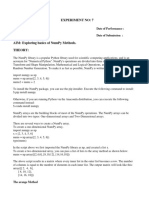0% found this document useful (0 votes)
30 views5 pagesNumpy
The document provides a comprehensive guide on using NumPy for array creation, operations, statistics, reshaping, indexing, and applying functions. It also covers random number generation, linear algebra applications including matrix multiplication, solving linear systems, matrix decomposition, eigenvalues, determinants, inversions, norms, and rank determination. Each section includes code examples and outputs to illustrate the functionality of NumPy.
Uploaded by
Harshitha ReddyCopyright
© © All Rights Reserved
We take content rights seriously. If you suspect this is your content, claim it here.
Available Formats
Download as PDF, TXT or read online on Scribd
0% found this document useful (0 votes)
30 views5 pagesNumpy
The document provides a comprehensive guide on using NumPy for array creation, operations, statistics, reshaping, indexing, and applying functions. It also covers random number generation, linear algebra applications including matrix multiplication, solving linear systems, matrix decomposition, eigenvalues, determinants, inversions, norms, and rank determination. Each section includes code examples and outputs to illustrate the functionality of NumPy.
Uploaded by
Harshitha ReddyCopyright
© © All Rights Reserved
We take content rights seriously. If you suspect this is your content, claim it here.
Available Formats
Download as PDF, TXT or read online on Scribd
/ 5
















































































